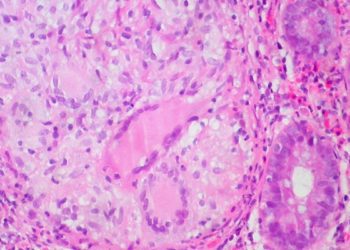Radiation from follow-up imaging may significantly impact life expectancy
1. In this modeling study, the greatest factor differentiating cumulative radiation dose between patients treated with surgery versus computed tomography (CT)-guided radiofrequency ablation (RFA) was that occurring from post-procedural— rather than pre- or intraprocedural—CT imaging.
2. The difference in decreased life expectancy between RFA and surgical management was 11.7 days in men and 14.6 days in women.
Evidence Rating Level: 2 (Good)
Study Rundown: Cumulative radiation exposure in diagnostic imaging can pose a mortality risk due to radiation-induced tumors and local tissue effects. This may be particularly true when imaging is used in situations requiring repeated sessions—such as pre-procedural planning—or post-procedural imaging follow-up of image-guided procedures, which lack the certainty of a surgical margin and therefore require close surveillance for recurrence. In the current study, a mathematical model based on retrospective patient data was developed to examine the effect on life expectancy of cumulative radiation exposure among patients treated with radiofrequency ablation (RFA) for renal cell carcinoma as compared to those who were surgically managed. Among a model population of 65-year-old men, those treated with RFA had a greater loss of life expectancy than patients treated surgically, which was primarily attributed to post-procedural follow-up CT imaging. This was found to increase as patient age decreased. The study was limited by the assumptions inherent in generating a mathematical model, including a paucity of data comparing recurrence rates between RFA and surgical management, risks caused by radiation dose-reduction strategies, and the true risk of secondary oncogenesis from radiation exposure. Future studies examining the use of magnetic resonance and dual-energy CT in follow-up imaging as a method of dose-reduction are warranted, as are long-term studies directly comparing outcomes of RFA to surgical management.
Click to read the study in American Journal of Roentgenology
Relevant Reading: Computed tomography: an increasing source of radiation exposure
In-Depth [population-based model]: A decision-analytic Markov model was made comparing calculated life expectancy in a cohort of 65-year old male patients following surgical or RFA management of unilateral renal cell carcinomas of less than 4 cm in size. The model included the risk of cumulative radiation exposure in both pre-, peri- and post-procedural imaging based on retrospective cohort data. Data regarding the risk of secondary oncogenesis was derived from published expert opinion parameters and from atomic bomb survivor cohorts. Radiation risks were computed in an organ-specific fashion, and average doses per RFA procedure and per post-procedure follow-up were based on institutional data across 30 subjects. Sensitivity analysis was performed to control for varying cohort ages from 55-75, sex, and risk of local recurrence. Calculated life expectancy losses attributable to secondary oncogenesis in RFA-treated patients were 14.6 days for men and 18.2 days for women, with corresponding death rates of 577 per 100 000 and 654 per 100 000 for each respective sex. In patients undergoing surgical treatment, life expectancy losses were 2.9 days and 3.6 days for men and women, respectively. The excess loss of life expectancy was 11.7 days in men and 14.6 days in women when comparing the two treatment strategies. Dose-reduction strategies in follow-up imaging produced the greatest reduction in loss of life expectancy in patients treated with RFA on sensitivity analysis, eclipsing even the cumulative dose incurred during the RFA procedure itself.
More from this author: Diffusion tensor imaging may aid Parkinson’s diagnosis, Perfusion imaging may predict successful thrombolysis in acute stroke, Stroke expansion following intra-arterial therapy may explain worse outcomes
Image: PD
©2014 2 Minute Medicine, Inc. All rights reserved. No works may be reproduced without expressed written consent from 2 Minute Medicine, Inc. No article should be construed as medical advice and is not intended as such by the authors, editors, staff or by 2 Minute Medicine, Inc.







